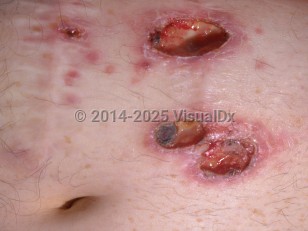Cutaneous amebiasis in Adult
See also in: AnogenitalAlerts and Notices
Important News & Links
Synopsis

Cutaneous amebiasis is caused by infection with pathogenic forms of Entamoeba histolytica. It is usually the result of direct extension from intestinal amebiasis or direct inoculation from stool, and in this latter context, is most common in infants wearing diapers.
In older children, cutaneous amebiasis is typically restricted to those with amebic dysentery, and it occurs in the perineal / genital area.
In adults, cutaneous amebiasis in the perineal / genital area usually occurs as a sexually transmitted infection, particularly in patients who practice anal intercourse, and manifests as a painful ulceration in that region. In particular, anal intercourse with persons suffering from amebic dysentery can result in a penile ulcer.
Other common routes for skin involvement include direct inoculation from colonic surgery on involved amebic colon or from draining a hepatic amebic abscess.
In general, cutaneous disease commonly presents as one or more painful ulcers that can become necrotic. Notably, ulcers tend to enlarge rapidly. If left untreated, progression is rapid and massive destruction of skin and subcutaneous tissues may ensue.
About 50 million people are estimated to develop intestinal amebiasis each year worldwide, and cutaneous amebiasis may occur in conjunction with other organ involvement or may be the only manifestation of infection. Entamoeba histolytica infection and morbidity is mostly experienced in Central and South America, Africa, the Middle East, and the Indian subcontinent. Most patients are male, with a 2:1 male to female ratio.
Usual symptoms of amebic colitis occur 7-21 days after exposure and include diarrhea, abdominal pain, fever, weight loss, and tenesmus.
Sexually active men who have sex with men and patients with AIDS are at higher risk for transmission, and malnourished individuals are more likely to develop cutaneous complications.
In older children, cutaneous amebiasis is typically restricted to those with amebic dysentery, and it occurs in the perineal / genital area.
In adults, cutaneous amebiasis in the perineal / genital area usually occurs as a sexually transmitted infection, particularly in patients who practice anal intercourse, and manifests as a painful ulceration in that region. In particular, anal intercourse with persons suffering from amebic dysentery can result in a penile ulcer.
Other common routes for skin involvement include direct inoculation from colonic surgery on involved amebic colon or from draining a hepatic amebic abscess.
In general, cutaneous disease commonly presents as one or more painful ulcers that can become necrotic. Notably, ulcers tend to enlarge rapidly. If left untreated, progression is rapid and massive destruction of skin and subcutaneous tissues may ensue.
About 50 million people are estimated to develop intestinal amebiasis each year worldwide, and cutaneous amebiasis may occur in conjunction with other organ involvement or may be the only manifestation of infection. Entamoeba histolytica infection and morbidity is mostly experienced in Central and South America, Africa, the Middle East, and the Indian subcontinent. Most patients are male, with a 2:1 male to female ratio.
Usual symptoms of amebic colitis occur 7-21 days after exposure and include diarrhea, abdominal pain, fever, weight loss, and tenesmus.
Sexually active men who have sex with men and patients with AIDS are at higher risk for transmission, and malnourished individuals are more likely to develop cutaneous complications.
Codes
ICD10CM:
A06.7 – Cutaneous amebiasis
SNOMEDCT:
111910009 – Amebiasis
A06.7 – Cutaneous amebiasis
SNOMEDCT:
111910009 – Amebiasis
Look For
Subscription Required
Diagnostic Pearls
Subscription Required
Differential Diagnosis & Pitfalls

To perform a comparison, select diagnoses from the classic differential
Subscription Required
Best Tests
Subscription Required
Management Pearls
Subscription Required
Therapy
Subscription Required
References
Subscription Required
Last Reviewed:03/15/2017
Last Updated:03/15/2017
Last Updated:03/15/2017
Cutaneous amebiasis in Adult
See also in: Anogenital
